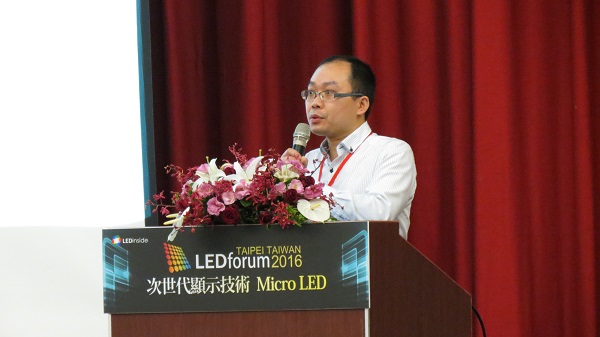(Author: Judy Lin, Chief Editor, LEDinside)
Osram Opto’s advanced optical designs and light contrast technology might one day be applied in next gen LED manufacturing, said Byron Liang the German lighting giant’s Marketing Manager of VIS LED department in its China branch.
 |
Byron Liang the German lighting giant’s Marketing Manager of VIS LED department in its China branch talked about the importance of optical designs at LEDforum 2016. (All Photos Courtesy of LEDinside)
|
Speaking about the importance of optical designs at LEDforum 2016 hosted by market intelligence company TrendForce’s LED research arm LEDinside on Sept. 30, 2016, Liang highlighted several important aspects in optical designs.
“The key in optical design is light distribution, to change its visual effect,” said Liang. “Another core technology is eliminating reflected light.”
In natural outdoor lighting or under ambient lighting conditions, the human eye will also receive reflected light, which is why manufacturers emphasize the brightness in devices used in outdoor environments needs to exceed 5,000 nits even 7000 nits, he explained.
However, filtering reflected light to eliminate interfering reflected light on screens for better visual experience can be challenging.
This is where optic design can be helpful in directing light to the desired angle in various device applications, lowering luminous output waste and impact from reflected light.
LEDs for instance might benefit from miniature lens and optic designs to help correct certain display issues.
Oval optic designs by Osram can be effective in overcoming this issue instead of adding secondary optics onto SMD LEDs, said Liang.
“This is mainly because the horizontal angle required is 120 degrees, but you do not need the same angle vertically…which would be a waste from an optical design perspective,” he added.
 |
|
“By adding lens to SMD LEDs, there are basically 11 parameters that affect light distribution,” said Liang, but did not go into details about the parameters at the forum. “Precision in the manufacturing process and the lens position placement will also affect the optical design outcome.” |
With an oval lens optical design such as the displix oval lens package the horizontal degree is controlled within 110 degrees, and the vertical in 60 degrees, which narrows the light to a certain area and limits light output waste. The margin of error for red light distribution using oval optical design isvery low, and keep quite stable and good radiation, with a vertical angle of 60 degrees and a horizontal angle of 110 degrees.
Different display applications will have various lens degree angle requirements, for instance billboard displays seen around highways require an optical angle of 30 degrees, but a small indoor display on a bus might require a wider lens angle of 60 degrees. And that bus stop and commercial ad display might require an even wider angle at 120 degrees, he said.
“By adding lens to SMD LEDs, there are basically 11 parameters that affect light distribution,” said Liang, but did not go into details about the parameters at the forum. “Precision in the manufacturing process and the lens position placement will also affect the optical design outcome.”
Applying Black Body lighting contrast technology in next gen LEDs in the near future?
Osram is also in the process of developing Blackbody LEDs to improve contrast and readability in displays, the dark substrate based LEDs are capable of raising contrast and improving it by minimizing area that reflects ambient light.
This technology is applicable in fine pitch for indoor applications and large outdoor LED display, as it absorbs stray light, lower reflection under direct sunlight, provide high contrast, good consistency, and improve picture or video display effect.
An example of how the low-reflective Blackbody SMD LED works can be demonstrated by laying an iPhone 6 next to iPhone 5 under sunlight, the iPhone 6 which uses similar Blackbody SMD LED technology will offer better image resolution and performance compared to traditional display technology.
In contrast traditional display technologies are often not bright enough under direct sunlight, or too bright at night causing light pollution. When turned off displays can also appear mottled, and video and picture quality can be rather poor.
This concept can be applicable in LEDs that do not require a reflector, and can be made into white LEDs that shrunken to micron size of 6 microns would be equivalent to LEDs.
LEDs would be suitable for indoor lighting in small, mid and large displays, while Blackbody LEDs are suitable in larger displayed lights or displays.
As global leader in LED technology, Osram launched three-in-one integrated RGB LEDs for display applications in 1999, said Liang. In 2008, the company introduced 1616 LED, which was then the smallest RGB three- in- one LED.
Yet, once the company masters 1010 and 0808 LED packages, it might change its focus in the near future from miniaturizing small packages to transferring LEDs onto black body epiwafer substrates to make large sized displays with high lighting contrast.
Large indoor LED displays in the future might comprise of 16 sets of RGB modules or even 64 sets of RGB modules to achieve smaller pitch size, better optical design, and more reliable products, he concluded.













